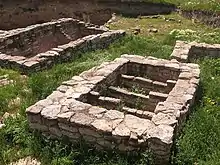Tyritake
Tyritáke (Greek: Τυριτάκη) was an ancient Greek town of the Bosporan Kingdom, situated in the eastern part of Crimea, about 11 km to the south from Panticapaeum. It is tentatively identified with the ruins in the Kerch district of Kamysh-Burun (Arshintsevo), on the shore of the Cimmerian Bosporus.
Τυριτάκη (in Ancient Greek) | |
 | |
.svg.png.webp) Shown within Crimea | |
| Location | Kerch, Autonomous Republic of Crimea/Republic of Crimea, Ukraine/Russia |
|---|---|
| Region | Taurica |
| Coordinates | 45°16′37″N 36°24′25″E |
| Type | Settlement |
| Area | 50 ha (120 acres) |
| History | |
| Builder | Settlers from Miletus |
| Founded | 7th or 6th century BC |
| Abandoned | Approximately 370 AD |
| Periods | Archaic Greek |
| Cultures | Greek |
| Site notes | |
| Condition | Ruined |
| Ownership | Public |
| Public access | Yes |
There are only few short mentions about Tyritake in ancient literary sources (Stephanus of Byzantium, Ethnika 642, 12; Pseudo - Aelius Herodianus, De prosodia catholica 315.12; Claudius Ptolemy, Geography 3.6.3.2; Ps. Arrian, Periplous Ponti Euxini 50,9 and Gaius Plinius Secundus, NH 4, 86-87 who names the city as Dia). First serious excavations, started in 1932 (headed by J. Marti) and have been followed in 1946-1957 by great Bosporan Expedition headed by prof. V. Gaidukievich. In 70s and 80s the territory of Tyritake was excavated by an expedition from the Kerch Museum headed by D. Kirilin and O. Shevelev and since 2000 the project "Bosporan City Tyritake" directed by prof. V. Zin'ko. In 2008 the Polish Archaeological Mission Tyritake of National Museum in Warsaw, with Alfred Twardecki as director, joined the project.
All these archaeological projects were able to establish that the colony, founded about the mid-6th century BC, specialized in crafts and viticulture. In the first centuries AD, fishing and wine production became the economical mainstay of the town. Tyritake was sacked by the Goths in the 3rd century AD and again in the 4th century by the Huns, but a settlement on the site continued into the Middle Ages.
See also
- List of Ancient Greek cities
References
- (in Russian) Tyritake on the official website of the Crimean government
- (in English) - Site of Polish Archaeological Mission "Tyritake"
